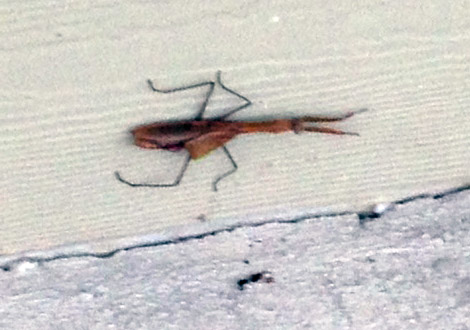First Christmas tree tip of the season
Apologies for using the C-word already, but my local grocery store put out the Christmas stuff the day after Halloween and my local nursery has a big sign up reading “Christmas trees are here.” So, if you’re going to join in and jump the gun by getting a cut tree anytime soon, you need to care for it correctly or it’ll lose its last needle on Christmas Eve — especially this year, as many trees are going to arrive drier than usual.
Be ready to saw a few extra inches off the bottom of the trunk when you get your tree home (a bow saw is ideal for this). And then sit the freshly cut stump in a big bucket of water for 24 hours, adding water if necessary. Do not bypass this step!
Rain was super-scarce this fall in many prime growing areas, and cut trees are going to need extra hydration to make it through the holidays.
And 24 hours is a minimum. If that bucket keeps running dry, keep adding water until the tree is fully saturated.
… Unless you like your carpet served extra sharp …
Don’t take holiday cuttings during warm weather
Here’s a quick primer on harvesting some of your own plants for holiday greens.
Pruning outside of the dormant season (the middle of which is the deadest dead of winter) stimulates growth, and stimulating new growth at this time of year is bad for plants. It saps energy from the root system, and that new growth is very prone to winter injury.
So whatever you do, don’t take cuttings during a warm spell. Try and wait until we’ve had a couple of hard freezes and then take cuttings of your hollies and evergreens during a run of cool, cloudy weather. The longer you wait, the better for the long-term health of your plants.
And c’mon — Thanksgiving is still two weeks away! Don’t even think about picking up your pruners until you start putting on your winter gloves!
Scared of snow? Score some sand!
Some of our region’s top weather-guessers have recently begun predicting heavy snow after the New Year. And while “reliable snow cover” is a pain for drivers, it’s a boon to our plants. Snow makes perfect insulating mulch for perennials. And a winter with some snow on the ground most of the time typically results in the best spring and summer bloom. (The worst weather for plants is a cool, windy winter without any snow; it just sucks the life out of the poor plants.)
But snow also means ice, which you must keep off your walkways so you don’t fall-down-go-boom and break your shoelaces.
One great risk-free way to prepare for de-icing now is to buy a bag or two of all-purpose sand. Also labeled as “play sand,” this natural product provides great traction on walkways without any harm to nearby plants. In fact, swept-off sand is good for lawns and landscape plants struggling to survive in our clay soils. You can use any leftover sand to lighten up the soil in your raised beds and container mixes in the spring.
Try that with your leftover rock salt!
Moving plants to a new home
Barbara in Essex writes: “I’ll be moving soon and want to take some of my beloved iris and day lilies to our new home. But I won’t be able to plant them until spring. Can I dig the bulbs up now and store them until spring?”
First, we had to warn Barb that outdoor plants are considered part of a property and can’t be taken without permission of the new owner. She replied that the house hadn’t sold yet.
Then, we warned her not to disrupt the landscaping too much anyway, as promising-looking perennials can only help a house sell faster in the spring. She assured us that she was just thinning out some overcrowded areas of plants that have long needed to be divided.
Good! That should even improve the look in the spring.
Now, the answer to Barb’s actual question: Yes, because the plants under discussion are not bulbs.
Real spring bulbs such as tulips, daffodils and crocus require precise chilling and vernalization, and need to spend the winter outdoors in the ground. But day lilies and iris are more like cannas, dahlias and other summer-blooming bulbs, in that they can be stored indoors in a cool place during the winter, with no danger to the following season’s show.
Carefully dig up those roots and rhizomes, gently brush off any loose dirt (do not wash them!) and place them in a cardboard box or paper bag filled with slightly damp peat moss. Store your treasures in a cool, dry spot and plant them anew in the spring.
(Note: If you’re not moving, don’t do anything. Iris and day lilies are fine left in the ground.)

Giant insects invade Manassas!
Yolanda in Manassas sent a photo of a strange-looking brown insect that only seemed to have four legs, and writes: “What is this?! It was outside my door this morning.”
I emailed back and told her to relax, that I didn’t recognize it, but was sure that, whatever it was, it was harmless.
Her reply? “But this thing was almost as big as my hand! It had to be at least 5 inches long and almost an inch wide. The antennae were about an inch long as well! At first I thought it was a strange praying mantis because there is a large field next door, but it doesn’t look like a mantis.”
Well, it didn’t look like one to me either. And it looked too wide to be one of those neat “walking stick” insects. But at a staggering 5 inches, those giants of the garden would be my top two choices.
So I turned to a local entomologist, who confirmed both guesses. She explained that it was a mantis, and that what looked like two long antennae in front are actually the other two legs stretched out. (All insects have six legs.) And she added that my walking stick idea wasn’t far off, as those weird and wonderful creatures are close relatives of mantises.
We told Yolanda the good news, and hope that she leaves her little giant alone to continue its life of preying on bad bugs!
Mike recommends…
Living History: Meet Gertrude Jekyll
7 to 8:30 p.m. Tuesday, Nov. 17, at Green Spring Gardens, 4603 Green Spring Rd., Alexandria
Garden lovers will meet Gertrude Jekyll, portrayed by a living history performer. Jekyll helped design and install hundreds of gardens in Europe and America from 1876 into the 1930s.
Admission is $10 for Fairfax County residents, 12 for non-residents. Four Season Garden Club members attend free. Registration recommended. Call 703-642-5173 or visit fairfaxcounty.gov/parks to register.







